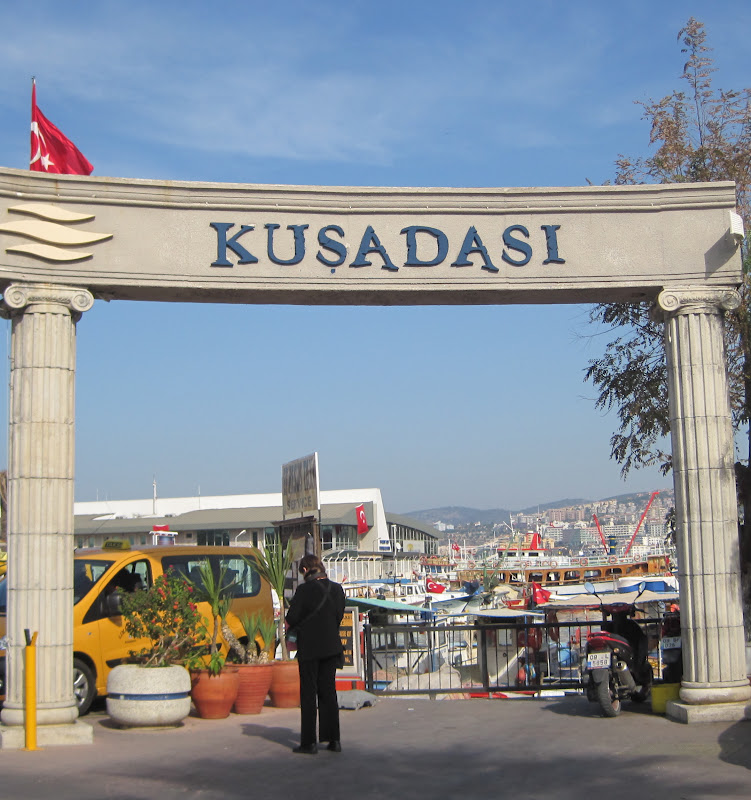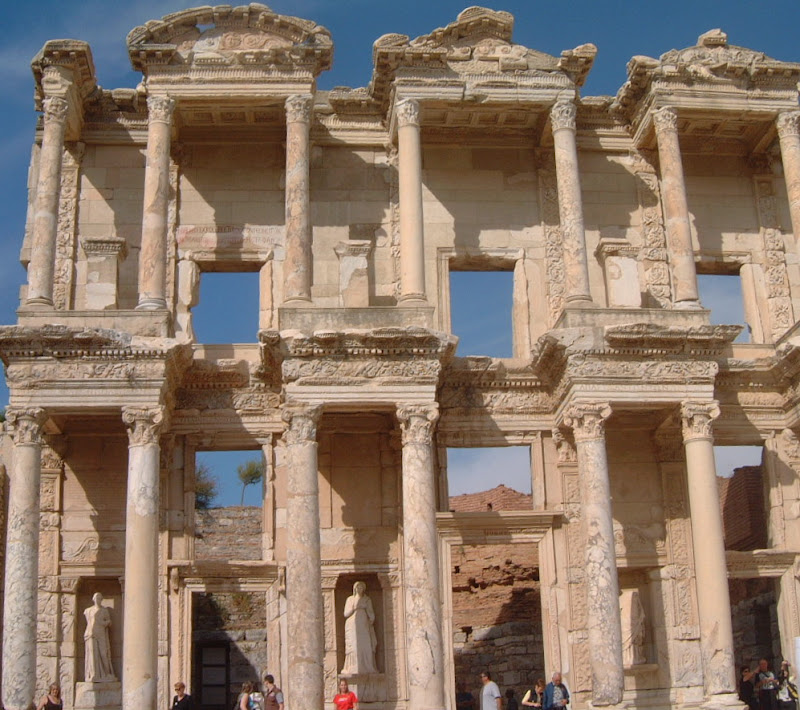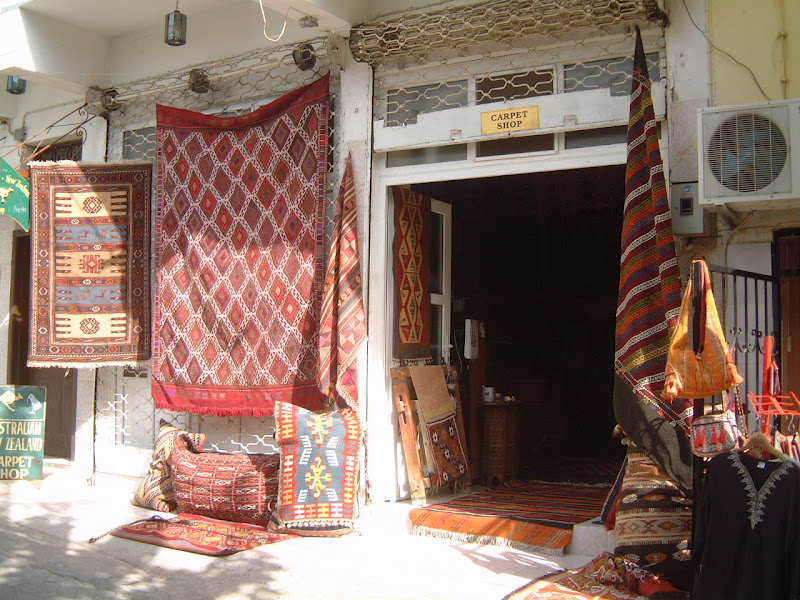BY: JANET STEINBERG
“So much of Ephesus remains that, no one in one lifetime
with the volumes of knowledge could absorb it.” S. Turkoglu – E. Atalay
On our recent Crystal
Serenity cruise, Kusadasi was the port of choice as its gateway to the ancient
archaeological site of Ephesus. Kusadasi, (pronounced koo-SHAHD-ah-sea) a lovely town on
the Aegean Sea, is a 25-minute drive through the Asia Minor countryside to the
fabled remains of the ancient city of Ephesus.
Serenity cruise, Kusadasi was the port of choice as its gateway to the ancient
archaeological site of Ephesus. Kusadasi, (pronounced koo-SHAHD-ah-sea) a lovely town on
the Aegean Sea, is a 25-minute drive through the Asia Minor countryside to the
fabled remains of the ancient city of Ephesus.
 |
| KUSADASI, GATEWAY TO THE ANCIENT ARCHAEOLOGICAL SITE OF EPHESUS |
Walking along the blazing
white marble Arcadian Way, one might have difficulty relating to Anthony and
Cleopatra, King Croesus, Saint Paul, Saint John the Evangelist or Mary the
mother of Jesus, all of who are said to have strolled those spine-chilling
streets. But movie buffs will have no difficulty picturing Charlton Heston gliding
through the ancient ruins in his chariot.
white marble Arcadian Way, one might have difficulty relating to Anthony and
Cleopatra, King Croesus, Saint Paul, Saint John the Evangelist or Mary the
mother of Jesus, all of who are said to have strolled those spine-chilling
streets. But movie buffs will have no difficulty picturing Charlton Heston gliding
through the ancient ruins in his chariot.
Throughout its varied and
often violent history, Ephesus
has always attracted greatness and grandeur.
Any attempt to condense this grandeur into one article would be folly.
Therefore, the following will highlight the major points of interest in a visit
to Ephesus.
often violent history, Ephesus
has always attracted greatness and grandeur.
Any attempt to condense this grandeur into one article would be folly.
Therefore, the following will highlight the major points of interest in a visit
to Ephesus.
GIRLS’ GYMNASIUM: As you
first approach Ephesus
on the east side of town, you’ll catch sight of the gymnasium with its many
excavated statues of girls. Many
historians think it is the only gymnasium built for girls in ancient times.
first approach Ephesus
on the east side of town, you’ll catch sight of the gymnasium with its many
excavated statues of girls. Many
historians think it is the only gymnasium built for girls in ancient times.
MAGNESIA GATE: Just across
from the gym are the foundations for the Magnesia Gate. It is the starting point of the road
connecting Ephesus
to the city.
from the gym are the foundations for the Magnesia Gate. It is the starting point of the road
connecting Ephesus
to the city.
STATE AGORA: In ancient
times, big cities had two agoras. One of
them was clearly the market place and thus called the “Market
Agora”. The other was the
“State Agora” where important social or political items were
discussed. The first area entered, upon arrival at Ephesus, is the State Agora. Considering its location in the high part of
the city, archeologists call it the Upper (or North) Agora.
times, big cities had two agoras. One of
them was clearly the market place and thus called the “Market
Agora”. The other was the
“State Agora” where important social or political items were
discussed. The first area entered, upon arrival at Ephesus, is the State Agora. Considering its location in the high part of
the city, archeologists call it the Upper (or North) Agora.
ODEON: To the right of the
State Agora is the Odeon, used as a lecture and concert hall. Its 23 seating rows have a seating capacity
of 1400. In front of the seats are an
orchestral stage and a marble main stage.
State Agora is the Odeon, used as a lecture and concert hall. Its 23 seating rows have a seating capacity
of 1400. In front of the seats are an
orchestral stage and a marble main stage.
PRYTANEUM: Originally, the
Prytaneum (Town Hall) was built by Lyimachos in the 3rd century B.C.. However, most of the remains are from the 1st
century A.D.. The most important
fragment left from this period is the altar containing the everlasting flame of
Hestia Boulaia, the Goddess of Fire.
Prytaneum (Town Hall) was built by Lyimachos in the 3rd century B.C.. However, most of the remains are from the 1st
century A.D.. The most important
fragment left from this period is the altar containing the everlasting flame of
Hestia Boulaia, the Goddess of Fire.
CURETES STREET: Named after the Curetes, the young girls who tended
the fires, this street stretches from the Prytaneum west via Domitian Square, where it joins Domitian Street and
descends as far as the Celsus Library.
Situated in the center of town, this 4th-5th century A.D. street was
unearthed in the years 1954-1968.
Entrances of important buildings, and statues of famous Ephesians, faced
and flanked the magnificent marble-paved streets.
the fires, this street stretches from the Prytaneum west via Domitian Square, where it joins Domitian Street and
descends as far as the Celsus Library.
Situated in the center of town, this 4th-5th century A.D. street was
unearthed in the years 1954-1968.
Entrances of important buildings, and statues of famous Ephesians, faced
and flanked the magnificent marble-paved streets.
FOUNTAIN OF TRAJAN: This
partly restored fountain, located on Curetes
Street, was consecrated to the Roman Emperor
Trajan in the 2nd century A.D..
Trajan’s foot, stepping on top of the world, symbolizes that he was the
ruler of the world.
partly restored fountain, located on Curetes
Street, was consecrated to the Roman Emperor
Trajan in the 2nd century A.D..
Trajan’s foot, stepping on top of the world, symbolizes that he was the
ruler of the world.
LIBRARY OF CELSUS: Behind a
large marble courtyard rises the third largest library in the ancient world.
Restorations of this beautifully preserved edifice, adorned with columns and
statues, began in 1970 and continued through 1978. An inauguration ceremony was held on April
29, 1978 and the library was opened to visitors after 1716 years.
large marble courtyard rises the third largest library in the ancient world.
Restorations of this beautifully preserved edifice, adorned with columns and
statues, began in 1970 and continued through 1978. An inauguration ceremony was held on April
29, 1978 and the library was opened to visitors after 1716 years.
 |
| THE LIBRARY OF CELSUS IN EPHESUS |
HOUSE OF LOVE (BROTHEL):
Located across the street from the library, the brothel was connected to the
library by a secret tunnel. Men would
tell their wives they were going to do some reading and then take the
underground passage to the brothel.
Just south of the brothel is the first advertisement of the ancient
world. Etched into the marble road, to
give directions to all visiting sailors–inland Ephesus was once a port–is a
heart (symbolizing love) filled with dots (symbolizing coins), a left foot
(signaling direction) and a female head (signifying the reward).
Located across the street from the library, the brothel was connected to the
library by a secret tunnel. Men would
tell their wives they were going to do some reading and then take the
underground passage to the brothel.
Just south of the brothel is the first advertisement of the ancient
world. Etched into the marble road, to
give directions to all visiting sailors–inland Ephesus was once a port–is a
heart (symbolizing love) filled with dots (symbolizing coins), a left foot
(signaling direction) and a female head (signifying the reward).
BATHS OF SCHOLASTIKIA:
Heated by steam circulating under the marble pavement and in the walls, these
(along with the public toilets and the brothel) formed a popular building
complex for men only.
Heated by steam circulating under the marble pavement and in the walls, these
(along with the public toilets and the brothel) formed a popular building
complex for men only.
MARKET AGORA (South): Passing through the gate of Mazeus and
Mithridates, to the right of the library, is one of the largest, and most
magnificent, agoras of the entire ancient world. In the center was a monumental horologion, a
combined waterclock and sundial.
Although the foundations of the clock were disclosed in the 1903
excavation, no further information about the rest of it has yet been
disclosed.
Mithridates, to the right of the library, is one of the largest, and most
magnificent, agoras of the entire ancient world. In the center was a monumental horologion, a
combined waterclock and sundial.
Although the foundations of the clock were disclosed in the 1903
excavation, no further information about the rest of it has yet been
disclosed.
GREAT THEATRE: Leaning on
the west foot of Pion
Mountain, the impressive
auditorium had a seating capacity of 24,000.
Exemplifying the gradual historical changes in theaters, this Great
Theatre has powerful acoustics. Standing on the stage, a voice will carry to
the very top row. You don’t believe
me? Try it. After repeated visits to Ephesus
over the last decade, there is little wonder why Saint Paul asked the question: “Is there
a greater city?”
the west foot of Pion
Mountain, the impressive
auditorium had a seating capacity of 24,000.
Exemplifying the gradual historical changes in theaters, this Great
Theatre has powerful acoustics. Standing on the stage, a voice will carry to
the very top row. You don’t believe
me? Try it. After repeated visits to Ephesus
over the last decade, there is little wonder why Saint Paul asked the question: “Is there
a greater city?”
One can hardly leave Turkey without
a little Turkish delight…by that I mean a little shopping and a little
tasting. In the nearby town of Selcuk, Ege Hali is a
carpet/kilim Co-op that offers both to the visitor. A unique experience awaits visitors who are
given the opportunity to observe the craftsmanship of carpet weaving first
hand. There is also a demonstration of
how silk threads are extracted from their cocoons and used in the making of
handmade silk carpets.
a little Turkish delight…by that I mean a little shopping and a little
tasting. In the nearby town of Selcuk, Ege Hali is a
carpet/kilim Co-op that offers both to the visitor. A unique experience awaits visitors who are
given the opportunity to observe the craftsmanship of carpet weaving first
hand. There is also a demonstration of
how silk threads are extracted from their cocoons and used in the making of
handmade silk carpets.
 |
| SHOPPING FOR CARPETS IS A TURKISH DELIGHT |
A typical simple Turkish
lunch of mezes (a wide variety of Turkish appetizers) and Turkish beer was then
served to prospective buyers at a picnic table set up under a tree. At the end of the meal, a cup of thick
Turkish coffee (with the sediment at the bottom) and some raki (lion’s milk) is
a must. Raki, like the Greek ouzo, is a
clear anise-based drink that turns white when ice or water is added. Don’t leave Turkey without trying locum, the
sweet jelly-textured confection officially known as Turkish Delight.
lunch of mezes (a wide variety of Turkish appetizers) and Turkish beer was then
served to prospective buyers at a picnic table set up under a tree. At the end of the meal, a cup of thick
Turkish coffee (with the sediment at the bottom) and some raki (lion’s milk) is
a must. Raki, like the Greek ouzo, is a
clear anise-based drink that turns white when ice or water is added. Don’t leave Turkey without trying locum, the
sweet jelly-textured confection officially known as Turkish Delight.
While in Selcuk, it’s worth
a visit to Art Ceramics. Here you can
watch artisans shape the clay on their wheels, draw and then paint the design
on their pieces, glaze them and then fire the ceramics in the kiln. Truly, the art of life.
a visit to Art Ceramics. Here you can
watch artisans shape the clay on their wheels, draw and then paint the design
on their pieces, glaze them and then fire the ceramics in the kiln. Truly, the art of life.
JANET STEINBERG is the winner of 38 national Travel
Writer Awards and an International Travel Consultant with The Travel
Authority in Mariemont, Ohio.
Writer Awards and an International Travel Consultant with The Travel
Authority in Mariemont, Ohio.
